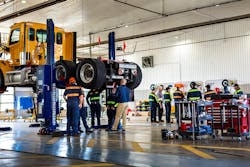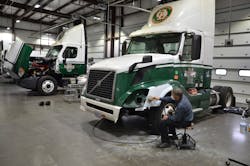Truck shops dig for root causes as vehicles add complexity
In the trucking industry, there is more interconnectivity between vehicle systems and components than ever before, which allows the asset to become safer, smarter, and more efficient. But this also creates complications for the maintenance professionals who will have to fix any problems that come up.
“Components are increasingly reliant on other vehicle systems to operate effectively, so diagnosing a single ECU will often not uncover the root cause of the problem,” said Sandeep Kar, chief strategy officer for Noregon .
Read more: How AI can help diagnose trucksIn fact, technicians must now diagnose the overall vehicle more holistically—to see each system as part of a larger entity to truly resolve the problem as opposed to temporarily relieving a symptom. This ranges from a paradigm shift in the way faulty components are diagnosed and repaired to the tools that detect the faults. And according to diagnostic experts who spoke to Fleet Maintenance, shops will need to upgrade both their skill sets and tools in short order, as the technological advances and complexity in trucking will not slow down so everyone can catch up.
The root of the matter
When trying to uncover a vehicle’s issue, some are easy fixes, such as topping off the coolant or diesel exhaust fluid. Others may take deeper digging with a diagnostic tool, some trial-and-error, and parts swapping. Even all that may not be deep enough to reach the real root of the problem.
“There is a very clear difference between making a repair that was created by a problem—or root cause— and solving the problem that created the need for a repair,” explained Randy Obermeyer, VP of safety and maintenance at OnLine Transport.
It’s a noble pursuit. Fix one DEF sensor and improve one truck’s uptime; help the OEM identify why the sensor failed and avoid future downtime for all similar trucks.
It’s the reason that Obermeyer chose “Root Cause Analysis/Problem Solving” as the major theme of his recently concluded tenure as general chairman and treasurer of the American Trucking Associations’ Technology & Maintenance Council.
He presented the following common method of resolving a check engine light:
First, the tech uses various troubleshooting steps, such as using a scan tool to find fault codes. Once the faulty component is identified, the quote is written and submitted for approval. Then the faulty component is repaired or replaced, and the invoice is sent and settled.
If another truck comes in with the same issue, the process repeats.
“Nowhere in this example is anything suggested as to what caused the component to fail,” Obermeyer noted. “It is not suggested that the component’s typical life expectancy was passed or if it failed prematurely.”
Obermeyer imagines an industry-wide workflow where repair facilities emphasize root cause analysis and problem-solving as part of the diagnosis and repair process.
Read more: TMC considers root-cause analysis at annual spring meetingIn this scenario, when dealing with a check engine light, the tech still goes through the troubleshooting steps to find the faulty component. Then the shop determines if the part failed early. Obermeyer noted this would take industry standardization and the customer’s repair history.
If the part failed early, the shop looks for obvious reasons, like a shorted wire, to understand why the component failed.
“If no, the repair facility digs deeper into the root cause, such as an internal component issue, an electrical voltage spike, internal wire or connection faults, etc.,” Obermeyer explained.
The quote would now include the cost to repair the current issue and list potential causes, and the tech then repairs or replaces the faulty component, and fixes the root cause if applicable. The invoice would also state the root cause and any potential countermeasures.
“The problem that created the need for the repair was solved, and the countermeasure is then put into place by the fleet which slows down and then potentially eliminates that particular issue from occurring on similar trucks,” Obermeyer explained.
It’s a comprehensive solution to problems that nag the industry, but it’s not without critics.
“I have had people push back saying that fleets will not want to pay extra for that service,” he said. “My answer: They cannot afford not to. Inflation has caused the price of my average component to go up 25%. There will be more expensive electronic control features added as ADAS and EV technology advance. Add that to skyrocketing labor prices at dealers and service providers. Why wouldn’t they?”
The former TMC chairman believes strongly that this is the best way forward and will continue to push the industry to shift from temporary to permanent fixes. His plans include helping develop a guide for teaching root cause analysis and making it a part of the curriculum at technician trade schools, adding a root cause track to TMCSuperTech and state skills competitions, as well as developing new root cause repair order and invoice standards for dealers, service providers, and fleets.
He also hopes to create a certified Root Cause Analysis Specialist Program similar to that of the VMRS Specialist Program currently offered by TMC.
Troubleshooting tool trends
Not only do technicians need to be better trained and acclimated to a problem-solving workflow, but they have to have a more capable array of diagnostic tools at their disposal.
“With technology advancing at an accelerated pace in Class 8 trucks, proper diagnostic equipment is a requirement for getting customers back on the road quickly,” explained Eric Daniels, VP of truck care for Love's. “And proper triage with diagnostic equipment helps drive throughput and technician efficiency.”
For Winston Minchew, maintenance training manager for Old Dominion Freight Lines, diagnostic software for fault code diagnostics is essential.
“You definitely need that with today’s engines, today’s aftertreatment systems, and all of the modules on the vehicle,” he said.
Read more: The tools and equipment of winning operationsDiagnostic tool providers have responded by developing more complex tools to avoid becoming obsolete, ensuring users have accurate information and increased efficiency.
“Overall, the evolution of comprehensive scanning tools for commercial vehicles has been marked by a steady increase in sophistication and functionality, driven by advancements in software, algorithms, and wireless technology,” said Marcos Obispo, sales director for Cojali.
More advanced diagnostic tools don’t have to complicate the user experience, and sophistication on the back end amplifies the need for a user-friendly experience on the front end.
“While scans are getting more sophisticated, the analysis from the scans is getting more predictive and prescriptive in nature,” Noregon’s Kar noted.
He added that tools can’t just present information to the technician but must guide them through the process. Without simultaneously scanning all components, technicians may find a temporary fix and clear the fault. Still, if the problem originates from another component, it will soon reoccur, causing unnecessary downtime and additional service expenses, Kar explained.
Duane Watson, a technical trainer for Bosch, said techs need a scan tool that can simultaneously communicate on different levels of protocols to speak to the various modules and protocol speeds. “Doing that will give me the information to drive to that root cause failure,” Watson said.
John Forro, a technical trainer specialist for Autel, added that a system that isn’t sending a signal to a module that needs it could cause a technician to spend a lot of time troubleshooting. “That is where a feature like the topology tool from Autel comes in,” he said.
Obispo said having bi-directional control allows technicians to communicate with a vehicle’s onboard computer system and perform tests and calibrations. “They also include features such as predictive maintenance, allowing us to anticipate and prevent problems before they occur,” he said.
Keeping Up
In addition to increased connectivity, today’s equipment uses much faster processors. “You have to have a tool that is faster than the equipment you’re testing,” said George Arrants, VP of ASE Education Foundation.
TMC recently submitted the first recommended practice for using lab scopes, which use live data, to diagnose an intermittent problem.
“Its sampling speed is faster than the truck’s computer. It can measure a billion samples a second and see things your multimeter and scan tool can’t see,” Arrants said.
Typically, scan tools use interpretive data. “That means there is a pretty good chance it is the correct data, but if there is a fault with the module itself, it can share anything, and we don’t know if it is correct or not,” Forro said. “If I pull up the MaxiSys tool, I can split the screen and put the scan tool data on one side of the screen and pull the lab scope data on the other side, so I can test what we see in the data is what the scan tool is seeing. If there is variance in the data, that gives you good insight that you’re looking at an actual module problem.”
Lab scopes help diagnose electrical issues, which often require additional tools. Autel utilizes a VCMI box, which has a reprogramming tool, four-channel lab scope, graphing meter, and a signal generator, all included with that scan tool.
Minchew said diagnosing electrical issues is more challenging today than it was ten years ago. “There are a lot more sensors, a lot more wires, and a lot more electrical modules,” he said. “When we test the wiring, the most important tool in the shop is the digital multimeter to ensure the wire is good.”
Troubleshooting ADAS
More and more vehicles support some level of advanced driver assistance systems (ADAS), which introduces new diagnostic hurdles. “Many quick and relatively simple jobs, such as replacing a windshield, have become more complicated due to the requirement to ensure ADAS systems are properly aligned and functioning correctly during the replacement,” Kar said.
For example, if a collision avoidance system is not functioning properly, a diagnostic tool can help identify the specific component or sensor causing the issue. “This allows for the quick and accurate repair of the system, reducing downtime and preventing potential safety issues on the road,” Obispo said.
Diagnostic tools can also calibrate ADAS systems after repairs or component replacement. “Calibration is critical to ensuring that these systems function properly and provide accurate information to the driver,” Obispo said. “Failure to properly calibrate ADAS systems can lead to inaccurate readings or false alarms, putting the driver and other road users at risk.”
ADAS sensors are mounted to the vehicle and assume the vehicle’s alignment is correct. Forro said that Autel’s IA900 has a built-in wheel alignment system to ensure a successful calibration.
Diagnosing Engines
There have been changes to engines which can require an advanced scan tool to diagnose, Forro said. “A lot of vehicles are going to secured gateway modules, which basically require that various manufacturers authorize that it is a legitimate scan tool,” he explained.
The growing use of hybrid and electric powertrains in commercial vehicles has created a need for diagnostic equipment that can diagnose and repair issues with the systems, which rely heavily on electrical components such as batteries, motors, and inverters.
“Additionally, these systems often include advanced engine technology, such as regenerative braking and energy management systems, which require diagnostic equipment that can accurately diagnose and repair issues,” Obispo said.
Obispo said that direct fuel injection systems often rely on advanced electrical components, such as high-pressure fuel pumps and injectors, to deliver fuel to the engine.
Testing Batteries
The right tools can help technicians diagnose battery issues and prevent battery-related problems from occurring in the first place. “By regularly monitoring battery performance and health, technicians can identify potential issues early on and take preventive measures, such as replacing a battery before it fails, to avoid more serious problems down the line,” Obispo said.
Autel can perform tests on low-voltage batteries inside or outside of the vehicle. “If we do the test outside of the vehicle, I can measure the available voltage of the battery and then apply the load to make sure it is going to be good under dynamic conditions,” Forro said. “If I do it inside the vehicle, I can do that testing and add the other starter and charging tests.”
Autel’s scan tool can also be connected to high-voltage batteries to recalibrate the battery range of health. “We refer to it as the modern-day tune-up,” Forro said.
Making the Investment
Each tool has its place, and Arrants said it comes down to knowing what you need and what you’re trying to accomplish.
Minchew said he looks for tools that will save time, which creates value. “You can decide whether or not the tool will pay for itself with that saved time,” he said, adding that he also factors in whether or not a tool will allow technicians to do more work in-house. “If you send trucks out because you don’t have a tool, the tool would end up paying for itself over time.”
The Old Dominion technician offered as an example changing from an analog to digital drum micrometer.
“Another tool that can save time is the dial indicator,” he added. “Maybe 20 years ago there was a dial indicator we purchased and used where you put articulating arms together. Now, there is a tool that you lock in an arm. It is easier to use and saves time.”
In this way, swapping out tools—not parts—could help foster a more holistic approach.
Forro said the ability to share the screen could allow shops to tap into other experts without physically bringing in a mobile diagnostics person, which can also save money. “With Remote Expert, we can keep the money in-house and search out the vetted industry experts to contract them,” he said.
Quality and flexibility are essential for the diagnostic tools used at Love’s Truck Care and Speedco locations. “We look for a product that is well supported by the vendor and flexible enough to service all makes and models,” Daniels said.
In addition to using OEM software, Love’s uses Noregon JPRO heavy-duty diagnostics in all shops. “This tool, along with their NextStep Repair, gives our technicians interactive instructions for troubleshooting and repairs,” Daniels said.
JPRO has a Repair Mentor feature that guides users down the optimal diagnostic and troubleshooting path. “Features like Repair Mentor help newer technicians diagnose complicated issues with less assistance and empowers them to perform at the level of a technician who can manage the same process without that guided aspect,” Kar said.
Watson said scan tools are simply necessary to treat today’s equipment. “The bottom line is the importance of electronics and software has grown, so this has to be part of the complexity technicians think about. It is more than opening the hood. It starts with the connector under the dash,” Watson said.
Techs should also check tools regularly. “One thing we like to tell technicians is to test your test equipment and have it in working order before you need it,” Kar said. “This means ensuring the leads on your multimeter work and the device is calibrated before diagnosing an electrical issue. It also means ensuring your diagnostic software is up to date before it’s time to connect to a vehicle.”
Once shops invest in diagnostic tools, they must properly care for them. “The location where you store it is critical,” Watson said. “You’re not going to store it in a drawer other than one with sensitive tools. Be mindful of where you keep it. You don’t want to have it propped up on a plastic box next to your air compressor that vibrates all day long.”
Daniels noted that it is important to keep tools clean and organized. “Having a well-organized shop not only helps with safety but also allows tools to be properly stored and easily accessible for all technicians,” he said.
Training Technicians
Even the best tools can’t eliminate the need for training. Without training, technicians may struggle to diagnose and repair issues, leading to longer repair times, higher costs, and increased frustration for customers. “Training is your best asset when it comes to repairing complex vehicle problems, no matter what system the problem is in,” Forro said.
Minchew likes to know when upcoming changes to equipment will require a new tool so he can plan in advance. He added that technicians and the location’s leadership have to buy in to any new tool. “A lot of times, training helps you get the buy-in,” he said.
Love’s utilizes both hands-on and computer-based training for new technicians and the continuing education of technicians across the Love’s and Speedco networks. Daniels said technicians and mechanics can’t overlook the basics.
And in this way, a shop’s best tool to root out problems is, of course, the technician.
“No piece of diagnostic equipment will replace a quality visual inspection of components,” Daniels concluded.


